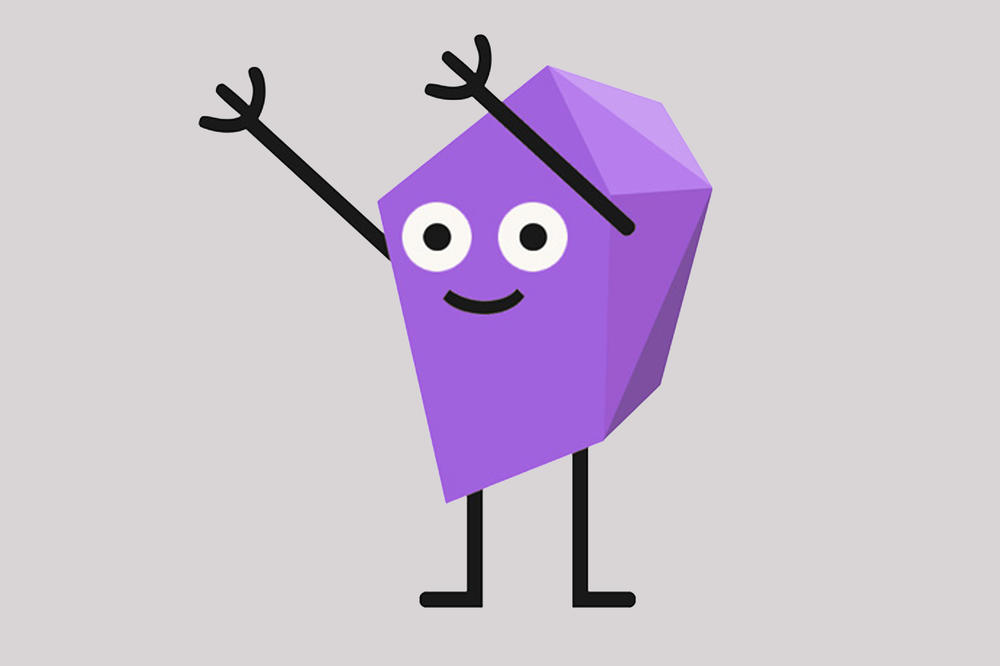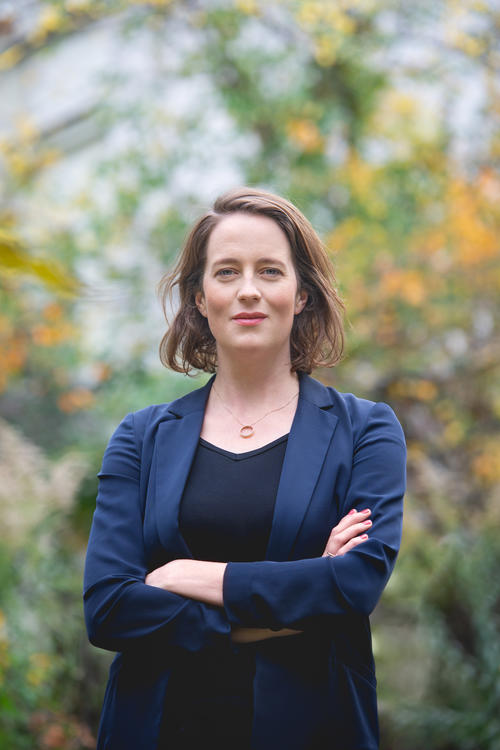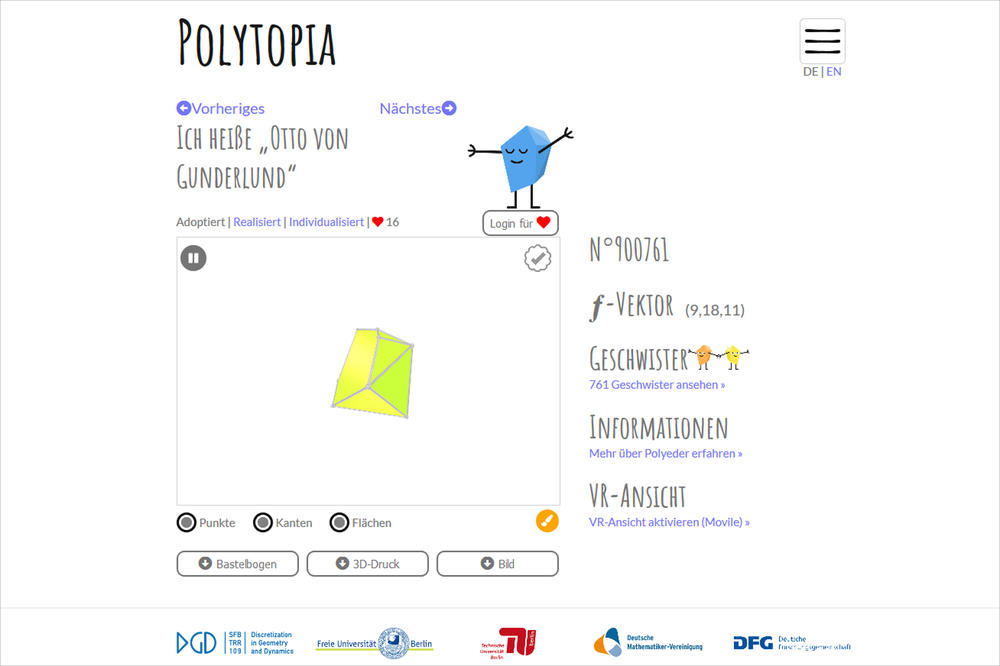Adopt a Polyhedron
Doctoral thesis of mathematician Anna Maria Hartkopf gives insights into world of polyhedra
Nov 06, 2018
Polyhedra are geometric figures that consist of corners, edge, and flat polygonal faces.
Image Credit: © Projekt „Adoptiere ein Polyeder“
They are named Eugen, Zauberhut, and Otto von Gunderlund; they have corners and edges, enjoy wearing neon colors, and their siblings also have unusual names. All three are polyhedra – geometric figures consisting of corners, edges, and flat polygonal faces, such as the cube or the pyramid. The special thing about Eugen, Zauberhut, and Otto von Gunderlund is that they were adopted.
On the homepage of the “Adopt a Polyhedron” project, those who are interested can choose one of the mathematical objects, color it, and give it a name – thus bringing it to life. More than 170 polyhedra have already found a sponsor. Sponsoring the geometric figure costs nothing. Anna Maria Hartkopf is the initiator of the project in which mathematicians from Freie Universität Berlin and Technische Universität Berlin provide information on the properties of polyhedra. The idea was born during her doctorate in the Discrete Geometry group at the Institute of Mathematics at Freie Universität Berlin. She hopes to have completed her doctorate by 2020.
Anna Maria Hartkopf, the project manager of “Adopt a Polyhedron,” has been a doctoral student in the working group Discrete Geometry at the Institute of Mathematics at Freie Universität Berlin since 2016.
Image Credit: Janine Kuehn
“With adoption, the polyhedra are taken out of the sphere of abstraction.” Anna Maria Hartkopf
It is important to the mathematician that everyone can participate in the project, regardless of previous mathematical knowledge. “Citizen Science” refers to this approach, in which citizens are actively involved in scientific research. The adopted polyhedra can be displayed three-dimensionally in virtual reality and can also be viewed with 3D glasses. They can also be printed out, painted, and assembled as a craft sheet. “This way, you can let your own polyhedron take a physical form,” says Anna Maria Hartkopf. Mathematics, i.e., depicting the combinatorial structure, is done almost incidentally.
At the same time, one gets involved in mathematics in a playful and creative way. Most polyhedra have neither a name nor a number. So far, only their combinatorial structure has been known, explains Hartkopf. “With adoption, they get a name. And with assembly, the polyhedra are taken out of the sphere of abstraction.” The working title of the project was therefore originally “Lost in Abstraction.” The sponsors then upload photos of the figures they have made to the project homepage. “This creates a collective art campaign with a scientific background,” explains the project manager, “therefore, Citizen Art.”
Anna Maria Hartkopf tries to interest people in polyhedra, both on- and offline.
Anna Maria Hartkopf has been involved with polyhedra since 2016, when she joined the Discrete Geometry group led by mathematics professor Günter M. Ziegler, now the president of Freie Universität. But she had already combined mathematics and art before. She coordinated the IMAGINARY exhibition for the Oberwolfach Research Institute for Mathematics for two years following her diploma in mathematics at Martin Luther University Halle-Wittenberg in 2011. The exhibition was conceived in 2008 in the “Year of Mathematics” and combines mathematics and art. It was so successful that it still exists today. “That was the first time I dealt with science communication in the field of mathematics, i.e., with making the subject accessible to a broad public.”
Anna Maria Hartkopf does not only try to enthuse people for polyhedra online. Among other things, she presented the project at the Science Slam as part of this year’s Long Night of Science at Freie Universität Berlin, at workshops in schools, and she also developed teaching materials for grades five to eight. Although polyhedra are not part of the subject matter in mathematics lessons, they have many aspects that cover individual areas of the given topics. “The students really enjoyed it,” says the mathematician, who was herself a teacher at a Berlin comprehensive school before completing her doctorate.
“Otto von Gunderlund” was already adopted.
Image Credit: Screenshot von www.polytopia.eu am 7.11.2018
Anna Maria Hartkopf was supported in “Adopt a Polyhedron” by scientists from Freie Universität Berlin and Technische Universität Berlin, for example, in programming the website and creating the virtual reality function, and by teaching experts in creating the school material.
“Adopt a Polyhedron” is a subproject of the “Discretization in Geometry and Dynamics” Collaborative Research Center (CRC). The CRC is a so-called Transregio, a merger of Technische Universität Berlin and the Technical University of Munich. Freie Universität Berlin is involved in various subprojects, including “Adopt a Polyhedron.” The CRC is funded by the German Research Foundation (DFG) and the Polyhedron website is also supported by the German Mathematical Society (Deutsche Mathematiker-Vereinigung).
“With this civic science project, we want to create an opportunity to actively and creatively participate in mathematics,” explains Professor Alexander Bobenko, CRC speaker from Technische Universität Berlin. “Everyone is invited to participate in the project and adopt a polyhedron,” says Günter M. Ziegler, the president of Freie Universität Berlin, a mathematics professor, and Hartkopf’s doctoral supervisor.
“There is only one polyhedron with four corners, yet there are billions with 18 corners.” Anna Maria Hartkopf
Due to their utter simplicity, Anna Maria Hartkopf personally finds polyhedra extremely beautiful. They simply have corners, edges, and flat side faces from which you can build anything you want. “When you think about how many combinatorial possibilities there are, you quickly realize the variety that the polyhedra represent,” she says. “And when I slightly move one corner, the whole geometric figure changes. I find that incredibly exciting.”
The number of possible polyhedra grows rapidly with the number of corners. “For example, there is only one polyhedron with four corners, already more than 2,000 with nine corners, and quadrillions with 18 corners,” explains Anna Maria Hartkopf. Despite an increasing number of sponsorships, she therefore does not expect bottlenecks. “It is easy to guarantee supplying polyhedra to the world.”



